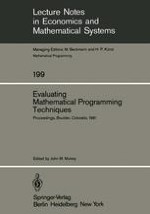1982 | Buch
Evaluating Mathematical Programming Techniques
Proceedings of a Conference Held at the National Bureau of Standards Boulder, Colorado January 5–6, 1981
herausgegeben von: Prof. John M. Mulvey
Verlag: Springer Berlin Heidelberg
Buchreihe : Lecture Notes in Economics and Mathematical Systems
Enthalten in: Professional Book Archive
